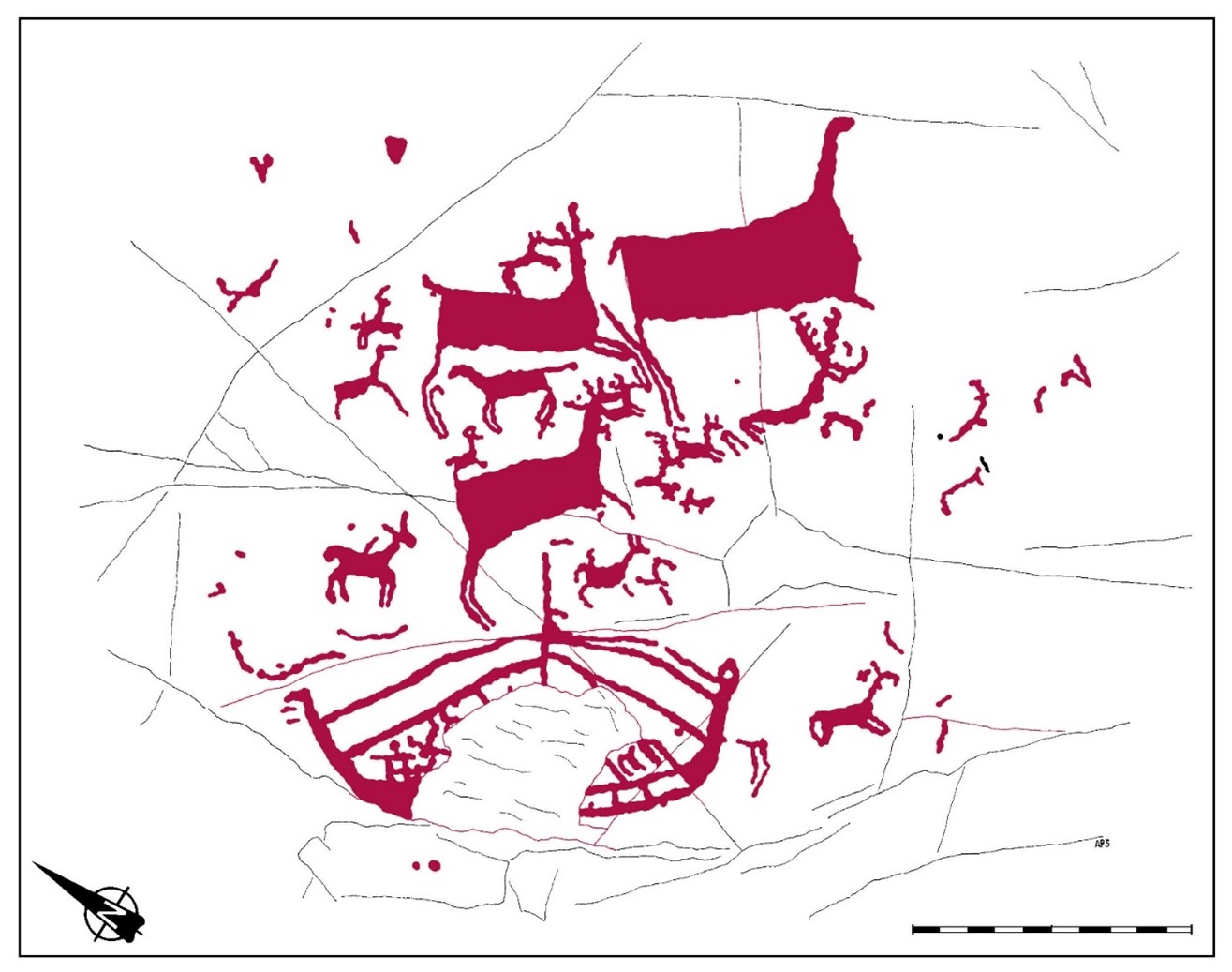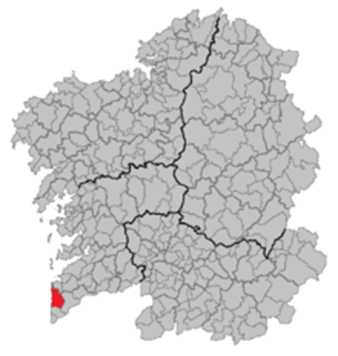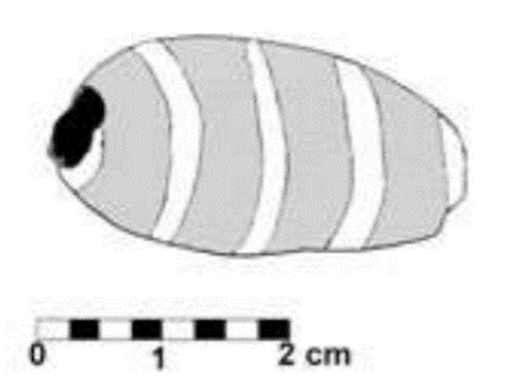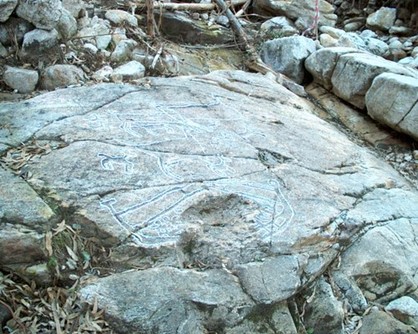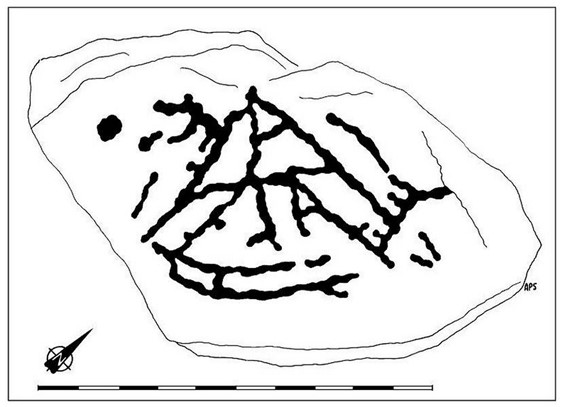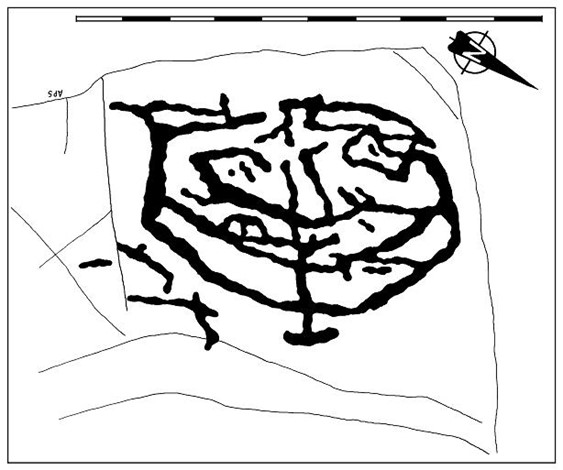Ship to the left with a large section amidships missing. Low slightly rockered hull and high vertical posts with a slight outward incline. The stempost has a slightly more pronounced outward incline compared to the sternpost and ends in an outward facing zoomorphic device, most probably a bird with a short flat beak. The sternpost ends in a circular, loop-like device. The aft section of the hull shows three rower's "rooms" demarcated by vertical stanchions. One fore- and two backstays leading diagonally from the mast to the stem and sternpost. One of the backstays is attached to the loop terminating the sternpost. Further down the mast, two diagonal lines extend to the stem and stern respectively, tied closer to their bases. This latter feature closely resembles the Gazi ship. The mast extends for a significant length above the stays. Further elements standing at gunwale level at the bow and stern are difficult to identify, possibly some human figures.
Galley
W1
13th-12th century BC (?)
Vigo
Laxe dos Cervos petroglyph. Large section chipped off amidships
Alonso 1995; Costas and de la Peña 2011; Estévez 2008 : 201-202, fig. 10.7; González Ruibal 2004: 289, fig. 2a; Ruiz-Galvéz 2005: 319-320, 338, fig. 4.5; 2014: 204, fig. 11.3
Several red deer petroglyphs on the upper part of a flat granite surface, with a ship below them. Since their discovery, scholars have called attention to the peculiar style in which the animals are represented. There is no guarantee that the deer and the ship are contemporaneous. The rock is located one kilometer from the coast, following the course of a small river called Vilar. According to Estévez, the petroglyphs are located in a sunken and nearly invisible area characterized by limited visibility (Estévez 2008: 202). Alonso on the contrary stresses that the rock commanded a view of the Santa Maria de Oia bay, which besides Mougás is the only natural harbour where it was possible to disembark with some security along this stretch of straight, rocky and dangerous coastline (Alonso 1995). The unique representations from Galicia show that this coast enjoyed recurrent visits of ships venturing beyond the Pillars of Heracles. Contact between the Galician Atlantic coast and the Mediterranean are best understood in terms of the region's role as a corridor for the supply of tin and gold, the former being found in northern Portugal, Galicia, and the British Isles. A rescue excavation at the Vigo University Campus (Vigo, Pontevedra) located not far from the petroglyphs uncovered a LBA silo where a glass bead through to be of Mycenaean origin was found, finding parallels dating to LH IIIB (González Ruibal 2004: fig. 2b). There are two additional probable ship graffiti in the area, but their morphology and interpretation is less certain.
The ship is definitely a galley. The schematic rendering of the figurehead makes it difficult to distinguish whether the Helladic hybrid creature is intended or rather the straight-beaked bird-head known from the Levant. Morphologically the best parallel is L12 from the Carmel Coast. The similarities with the Carmel non-Aegean ship graffiti also extends to the lack of a cutwater. The only problem is that Levantine activity this far west remains largely undocumented for the LBA. Another possibility is to date the ship to the EIA, interpreting the figurehead as that of a horse instead and thus equating the vessel with the hippos type. The depiction of the rower gallery and the possible find of a Mycenaean bead nearby somewhat favour the a reading as an Aegean-related vessel. The location of the graffito at a privileged visual point and in association with a rare practicable port in a difficult and dangerous navigation area is significant. The shallow draught of the galley design combined with an oared propulsion system would have been particularly beneficial for navigating narrow entrances and to ascent along rivers.
Alonso, F. 1995. “La embarcación del petroglifo Laxe Auga dos Cebros (Pedornes, Santa Maria de Oia, Pontevedra),” in Actas del XXII Congreso Nacional de Arqueología. Vigo, 1993. Vigo: Xunta de Galicia, Consellería de Cultura, Dirección Xeral de Patrimonio Histórico e Documental, pp. 137-45.
Costas, F. and de la Peña, A. 2011. Los barcos de los petroglifos de Oia. Embarcaciones en la prehistoria reciente de Galicia. Vigo: Autoridad Portuaria de Vigo.
Estévez, M. S. 2008. Petroglifos y paisaje social en la Prehistoria Reciente del Noroeste de la Peninsula Iberica. TAPA: Traballos de Arqueoloxía e Patrimonio 38. Madrid : Consejo Superior de Investigaciones Científicas.
González Ruibal, A. 2004. “Facing two Seas: Mediterranean and Atlantic Contacts in the North-West of Iberia in the first millennium BC,” OJA 23: 287-317.
Ruiz-Galvéz, M. 2005. “Representaciones de barcos en el arte rupestre: piratas y comerciantes en el tránsito de la Edad del Bronce a la Edad del Hierro,” Mayurga 30: 307-339.
―――. 2014. “Before ‘the Gates of Tartessos’: Indigenous Knowledge and Exchange Networks in the Late Bronze Age far West,” in A. B. Knapp and P. van Dommelen (eds.) The Cambridge Prehistory of the Bronze and Iron Age Mediterranean. Cambridge: Cambridge University Press, pp. 196-214.



